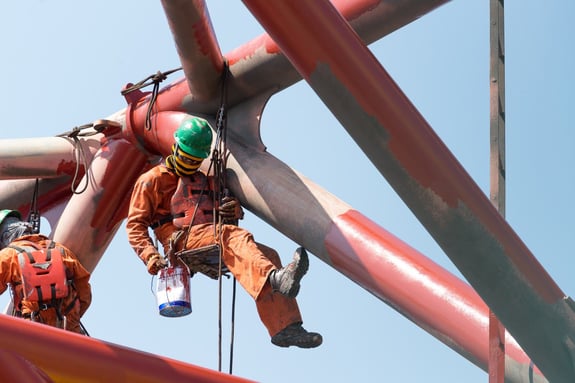
It’s no big surprise that falls are the leading cause of death in the construction industry. Almost 40% of deaths in this industry are due to falls. It’s also one of the biggest things companies get cited for… every single year. You don’t get a second chance in safety, so make sure you provide your crew with the right protection the first time.
So, how do you choose the right fall protection systems for the job, when the job is always changing? Well, for starters, you better make sure you do a thorough job hazard analysis. Every time! Buy equipment that will do the job. Anything else is a waste of your time and money.
And you know those worst case scenarios that no one wants to think about? You better think about them; and have a plan in place to protect your people and CYA (cover your assets, right?)
What should be included in your Fall Hazard Assessment?
- Can you eliminate the hazard? Sometimes we can avoid the hazard to begin with, either by changing the process, location, or schedule of a job. Can a machine do the task, saving a worker from having to be exposed to hazard? Eliminating a hazard will always be the best bet, so make sure this is your first step.
- Location of work to be performed: Where is the location of the work to be performed (roof work, marine, walking-working surfaces, leading or sharp edges)? Remember that leading edges require special fall protection; choosing protection meant for standard applications could be deadly.
- Identify trip hazards: These can be anything that can potentially trip a worker and cause a fall; air hoses, extension cords, machinery, tools, debris, spills, obstructed view, clutter or uneven walking surfaces. Make sure your site is free of any unnecessary hazards. Make accommodations for objects at height, dropped tools can kill!
- Is work area considered to be a confined space? Confined spaces are an entire beast of their own and require specific fall protection and gas detection devices. Don’t overlook this critical piece of info.
- Oily or slick surfaces: Will the worker also have to deal with undesirable conditions while working at height? Water, oil and dust are just a few of the added dangers workers may have to contend with.
- Lighting/visibility issues: Is there adequate light? Is there a potential for smoke or dust to cut down a worker’s ability to see fall hazards?
- Rescue/descent plan: Have you taken the time to come up with a “what if” plan of action for an emergency? How is the worker going to get back to safe ground after a fall? Is worker wearing PPE that will increase chance of survival and decrease injury if involved in a fall?
- Inspection of equipment: In the case of self-retracting lifelines (SLR’s), the user must do an inspection before each use to ensure good working condition. A competent person must inspect the equipment at least annually if there is infrequent use. And the user must inspect daily! The more the equipment is used and the worse conditions they are used in, inspections can occur as much as quarterly.
- Record of training: Keep employee fall protection training documented so you always know the competencies of a worker. Even when they have worked for you for a long time, if they show signs of not using fall protection correctly… pull them and train them again.
- Re-inspection: Work areas change and in the construction industry fall protection needs change daily. Stop. Look. Think. Work Safe.

Keep Local and Federal Agencies off your Back:
Know the rules. Big changes have been made concerning fall protection, especially the Final Rule on Walking/Working Surfaces. Make sure you use the specific equipment that can meet the demands of leading edge applications:
- Increased Fall Distance
- Lock-Up Speed
- Increased Potential for Swing Hazard
- Increased Fall Arrest Forces
Ok, so now what equipment do I need for leading edge?
- MillerTurbolite™ EXTREME: Galvanized cable lifeline designed for use in sharp edge applications with radius = 0.005" (0.13 mm).
- Daytona Big Block Self-Retracting Lifeline: Constructed with ergonomic handle, coated and heat treated brake pawl bolts this grade 8/ impervious to salt water contamination assembly is available in 50’ or 65’ models.
- 3M™ DBI-SALA® Nano-Lok™ Edge Self-Retracting Lifeline: Designed for foot-level tie off and ergonomically designed for comfort. Requires fall clearances as low as 16’ and limits average arresting forces to 900 lbs. or less. Comes with integrated, backpack style energy absorber that works with connector to limit forces to protect against sharp edges.
Fall protection is not one size fits all. Not for the job, not for the person. And if you get stuck buying equipment for the sole reason of meeting some minimum requirements, you are going to get burned. Factor the cost of safety equipment into your budget at the beginning stages. PPE is often what gets hit the hardest at budget review and that’s a big mistake, that’s when people get hurt. Buy equipment that your crew will wear and that will protect their lives. There are no documented instances that a company went bankrupt for buying safety equipment. There are, however, instances when injuries occurred and the proper PPE was not used. Let that sink in.
Safety: It's Your Life, It's Our Business






